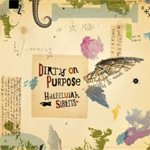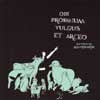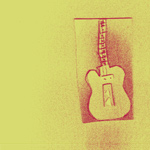- Gary Suarez
- Albums and Singles
Wasting little time, M.R.K.1 bursts through the gate on the A side with an astounding beat heard by many on the recently re-issued Virus Syndicate album The Work Related Illness and its preceding "Ready to Learn" single. Renamed "Ready for Love," this soulful stunner surpasses most of his already commendable catalog with dizzying percussion and one of the catchiest vocal hooks I've heard this year. The remainder of the record can't meet the impossibly high standards set by this undeniable single. "Daywalker" retreats to the familiar dark terrain of the One Way album, with cinematic samples and orchestral strings setting the stage for combat. Surprisingly melodies emerge on the flipside, and there's almost a Luke Vibert quality to the squelchy, quasi-acidic "Rat Trap" and the dreamy noodling of closer "Stardust," implying some sort of underlying linkage between M.R.K.1 and the rest of Planet µ's seemingly disparate, eclectic roster.
Read More
- Administrator
- Albums and Singles
 On the second full-length from Drop The Lime, Luca Venezia throws down heavy beats that probably won’t lure anyone not previously so inclined onto the dance floor, yet the album never gives those already there a reason to leave.
On the second full-length from Drop The Lime, Luca Venezia throws down heavy beats that probably won’t lure anyone not previously so inclined onto the dance floor, yet the album never gives those already there a reason to leave.
As the title suggests, the songs themselves loosely share an afterhours theme, invoked by the opening “Wake Up Call”: “This city is calling/On your hopes and your dreams/Midnight is falling/Till the skies ever bleed.” After the brief intro arrives an intimidating wall of rhythm that commands obedience, announcing that the party starts here.
The first half of the album is nearly flawless in its pace, leaving little room to breathe. The vocals steer the songs away from being purely beat-driven and give them a mostly memorable pop edge. “Coal Oven Fires” has a couple of vocal breaks that offer a brief respite, while the soul-tinged singing in “Butterscotch” briefly lends the song a poignant touch. The album stumbles a little bit in the second half, starting with “E-Lock,” a more traditional dance track that’s ultimately forgettable but for the snarky laugh that occasionally intrudes. “Bella” comes across as a short, obnoxious remix more than something truly original. Following this, however, is the highlight of the album, “Full Moon Rising,” an energetic, rabble-rousing stomp with a recurring group chorus that, after a string section salve, returns for the last time with its ranks swollen by a legion. The ending of the album is awkward, starting with “Triceratops,” a repetitive instrumental that goes on for too long. “Turn Out the Lights” is a peaceful down-tempo song that would have been a nice ending, but instead the disc ends with “Skyline Fantasy,” which isn’t that bad in itself, but considering that the lights have already been turned off, comes across as the last guest at the party who refuses to acknowledge that the night is over, everyone has left, and it’s time to go home.
Despite a few slips, the rest of the album is a necessary reminder of how much fun good dance music can be.
samples:
Read More
- Administrator
- Albums and Singles
 Norway’s Terje Isungset returns to the Ice Hotel for his follow-up to 2002’s Iceman Is. Like that album, all the instruments used are made from ice, including ice percussion, iceofon, icehorn, and iceharp. Joining him is Sidsel Endresen, who co-wrote many of the songs and contributes vocals, for an album of ethereal, crystalline beauty.
Norway’s Terje Isungset returns to the Ice Hotel for his follow-up to 2002’s Iceman Is. Like that album, all the instruments used are made from ice, including ice percussion, iceofon, icehorn, and iceharp. Joining him is Sidsel Endresen, who co-wrote many of the songs and contributes vocals, for an album of ethereal, crystalline beauty.
Such an undertaking is no easy task. Not only must the instruments be created on the spot, but so do the soundproof igloos in which they’re to be recorded. The blocks of ice themselves must be perfect, without bubbles or dirt, to be suitable. Chainsaws remove the bulk of extraneous material before knives whittle down the pieces further. Since the ice is delicate and often breaks during the process, there may be several false starts before an instrument is considered acceptable.
The music that results is surprisingly warm even though the compositions themselves are frequently skeletal. The ice possesses an organic timbre much like breath so that the spaces between notes never feel empty. The bass drum resonates more deeply than I expected, while the other percussion, and iceofon, hit like falling rain.
Most of the songs are ambient and meditative, letting the listener absorb their atmospheric qualities as much as their melodies. Other than on tracks like “Song” or “Wisdom,” the singing tends to be more pitch than language, or gets gutteral like on “Iceman 2,” soaring alongside the drones and overtones of the other instruments. “Bird” even finds the voice evoking its namesake as if surveying the wintry landscape from high above. The most active track on the album is “Mammoth,” finding propulsion in rhythm, a faint mechanical-sounding echo, and wheezing horns that race to the finish.
I wish liner notes detailing the procedure or at least photographs of the instruments had been included, but perhaps that would spoil some of the mystique. Even so, the disc comes with a vial of water embedded in the jewel case, symbolically uniting the product and the process. The music surpasses the gimmickry, however, sharing unique sounds that otherwise would go unheard. Although the album could have used more changes in tempo at times, perhaps that would only ultimately distract from the deliberate peacefulness of the locale and the music itself.
samples:
Read More
- Administrator
- Albums and Singles
 Brooklyn’s Dirty on Purpose cannot help but make elegant compositions out of simple ingredients. Layers of multi-tracked vocals, glittering melodies, and a subtlety of drone stack up in each song. This could be called space rock if it weren’t so firmly grounded in the terrestrial. It’s better described as dream-pop because the songs celebrate many of our earthly delights but viewed, perhaps, through the haze of a dream or memory. Hallelujah Sirens is a smart collection of songs which could be campfire serenades, lakeside dirges, or starry-eyed minuets.
Brooklyn’s Dirty on Purpose cannot help but make elegant compositions out of simple ingredients. Layers of multi-tracked vocals, glittering melodies, and a subtlety of drone stack up in each song. This could be called space rock if it weren’t so firmly grounded in the terrestrial. It’s better described as dream-pop because the songs celebrate many of our earthly delights but viewed, perhaps, through the haze of a dream or memory. Hallelujah Sirens is a smart collection of songs which could be campfire serenades, lakeside dirges, or starry-eyed minuets.
Dirty on Purpose concentrate on musical themes instead of concepts. Something about lakes, lights, and looking saturates the songs. It’s nothing particularly weighty, but rather good fodder for songs about sweet memories without being too sentimental. “Light Pollution,” with its dulcet guitar aiding the drumbeat crescendo, urges to “take the long way home,” a sentiment which is in danger of being cliché but here ends up just being something universal which we have all felt, if not sung to ourselves. In fact, this particular sentiment hasn’t enjoyed such privileged championing since the Piebald classic “Holden Caufield,” a song which tended towards the more maudlin instinct which Dirty in Purpose manage to (barely) avoid. But the two songs might have more similarity than you think. Although the band is unburdened by heavy music ideas, their music is intricately executed. Threads of harmony and rhythm are interwoven expertly, making an album which sounds at once both tight and airy. The songs are not over-wrought, breathing simply but not simplistically. “Marfa Lights” recalls Eric’s Trip (the band, not the song), though that band was ironically a much dirtier and fuzzier version of Dirty on Purpose. The exchanged male/female vocals favor the comparison, but there is something more genetic to the music which draws the comparison closer. Both bands share a likeminded sense of melody, echoing each other’s hooks, though you might have to work harder to distill the melody of Eric’s Trip from their rapturous sludge.
From the liner notes, I cannot discern if there are any female singers featured on the songs. I see that there is an androgynous-sounding backup singer called Jaymay, which could be a spiced-up version of the name Jaime. But the entire time I listen to the album I swear that I can detect the distinct breathiness of a double-X chromosome. Listen to the vocal flourishes on the first four songs and tell me that you don’t envision a fey-looking female vocalist standing on stage, holding no instrument but swaying sultrily to the music. If no female element exists, then the band has an impressive vocal range of hearty tenors to near-castrati who decorate each song delicately. “Summer Dress” relies on its fragile guitar theme, notes building in unison with the vocals. Neither instrument treads too carelessly on the other and as the song reaches its end with an impressive concord, you forget how dangerously close it came to shattering the whole way through. It’s a fine balancing act, carried out consistently through 11 songs and leaving me with the conviction that buying new music based on old tropes might be worthwhile again.
samples:
Read More
- Administrator
- Albums and Singles
Read More
- Administrator
- Albums and Singles
 If Songs Could Be Held is an incredibly bad album. Granted some of the music is pleasant and the entire disc is well produced but the songs are boring and mediocre at the best of times. Thomas is one of those too serious but not interesting enough singer songwriters that are ten a penny these days. There are dozens like her in every city, anyone can go see another identikit performer for free so there's no point in wasting money on this.
If Songs Could Be Held is an incredibly bad album. Granted some of the music is pleasant and the entire disc is well produced but the songs are boring and mediocre at the best of times. Thomas is one of those too serious but not interesting enough singer songwriters that are ten a penny these days. There are dozens like her in every city, anyone can go see another identikit performer for free so there's no point in wasting money on this.
Sub Pop
What bugged me most about Rosie's songwriting is the amount of clichés that she uses both in her lyrics and in her music. “Pretty Dress” is about not being accepted when you’re young and growing up to get your prince in the end. Pass the sick bucket please. Equally cringe and vomit inducing is “Let It Be Me,” a cover of the Gilbert Becaud song. A male voice duets with Thomas and he manages to sound as bored as I feel, it’s like Thomas slipped a couple of Valium into his drink prior to recording.
I’d love to find something on this album to enjoy but it is one painful song after another. Thomas’ earnest singing is a chore to listen to, she tries to worm in as many quivers and wobbles to her voice to let whoever is listening know that she is really feeling the power of her songs. The problem is there is absolutely no power to her songs. As a result her overwrought vocals sound trite and devoid of any real emotion. On “Tomorrow” she sings: “Birds fly above you/Love is around you/I would like to be too,” which is a terrible set of lyrics and Thomas does it no favours by having virtually no presence with her singing. As well as that, she warbles the word “above” so badly that I want to scratch the CD into being unplayable. No amount of vocal gymnastics can save a weak song from being anything other than a weak song (not that her singing is impressive enough to qualify for gymnastics).
If Songs Could Be Held is a wishy-washy excuse for an album. Rosie Thomas is a hackneyed songwriter who should be lucky to be playing open mic nights let alone getting a contract with a large record label. How she landed such a deal is a mystery to me, especially after being subjected to this CD.
samples:
Read More
- Administrator
- Albums and Singles
 On her second album, Italy's Miss Violetta Beauregarde packs 16 songs into a mere 20 minutes, yet each one brims with more ideas than some bands' entire albums. Created from crappy electronics, glitch beats, screams, with occasional samples and other noises, her frenetic, anarchic nihilism is a much needed kick in the head.
On her second album, Italy's Miss Violetta Beauregarde packs 16 songs into a mere 20 minutes, yet each one brims with more ideas than some bands' entire albums. Created from crappy electronics, glitch beats, screams, with occasional samples and other noises, her frenetic, anarchic nihilism is a much needed kick in the head.
Beauregarde broadcasts her attitude right away with the album title, which from the Latin roughly translates as, "I hate the common crowd and I spurn them." Yet as antisocial as she presents herself to be, she offsets much of it with bratty black humor, especially with titles like "Adolf Hitler's Emotional Side," "I Can't Believe, Hedgehogs Have a Bone Inside Their Cock," and my personal favorite, "I'm the Tiennamen Square Guy and You All Are the Fucking Tanks."
The album begins with "Flanger When You Die," a brutal assault that gradually transforms into beats underneath her imploring shouts. Other than "The Man Who Shot at the Squirrels (A Tribute to Glenn Benton)," most of the songs aren't quite so harsh but many come perilously close. Things aren't so chaotic all the time, with songs like "Try to Misunderstand This One" and "Tiennamen" flirting with pop, though she uses sneak attacks to subvert those conventional impulses. She slows things down a little with the mostly instrumental "How to Use a Good Idea Until It Turns Into a Bad Idea" before revving her engines again for another run.
Her approach is child-like as she grabs whatever bits and pieces draw her attention at the moment and drops them in favor of something else per her whims, assimilating her influences so quickly that they nearly vanish before they can register. As a result, her songs never have a chance to get stagnant or wear out their welcome. Almost always abrasive, they're also cathartic and invigorating. I can't complain that the album's sole flaw is its brevity considering that the remedy is simply to play it again before my frayed synapses have a chance to heal.
samples:
- Adolf Hitler's Emotional Side
- I'm the Tiennamen Square Guy and You All Are the Fucking Tanks
- I Can't Believe, Hedgehogs Have a Bone Inside Their Cock
Read More
- Administrator
- Albums and Singles
 Anyone that manages to weave a mystery around them are bound to win some fascination from appreciators and press alike. Whether or not there's any substance behind their mystery is another story altogether. Uton unveils floating events and sounds in the same way a magician unleashes doves from a hat or a sleeve, but without the awe or sense of wonder. Mystery Revolution amounts to a bunch of floating stuff and very little more.
Anyone that manages to weave a mystery around them are bound to win some fascination from appreciators and press alike. Whether or not there's any substance behind their mystery is another story altogether. Uton unveils floating events and sounds in the same way a magician unleashes doves from a hat or a sleeve, but without the awe or sense of wonder. Mystery Revolution amounts to a bunch of floating stuff and very little more.
Digitalis
At first I thought the cloud of popping and cracking sound that Uton opens this album with was going to resolve into a soft commotion of rhythm and melody. "Aikavirta" suggests crescendo and prologue, the slow accumulation of tension that makes every release such a wonderful feeling. I waited and waited somewhere until I realized that what I was hearing composed the whole of the album. I like abstract music a lot, but the best abstract has to offer always makes some reference to form and structure. Even the most nebulous albums ranked among my favorites feel as though they're traveling somewhere. If not, they're sustaining some sound, thought, or feeling that warrants such stasis. Mystery Revolution, on the other hand, begins adrift and ends adrift, without much in the middle to suggest a journey ever occurred.
Flutes, whistles, bells, chimes, analogue bellows, and all manner of fascinating source material manages never to come together for Uton. Whatever mystery his foggy music hides stays that way until they very end, negating and reflecting any light that even comes close to it. Strings buzz and shift restlessly on "Taivaan Sini Sokea (Soikea)," but never do more than that. They don't necessarily match very well with the other sounds on the song, they do not add to whatever sensation the song inspires (in my case, I feel almost nothing listening to this record), and they certainly don't seem to be arranged very well, becoming lost in the rest of the music. Everything seems to be arranged without forethought or plan.
Improvised music has its place and there are plenty of people who will swear by the possibilities it presents to the musicians and the audience when it is performed, but in this particular case all I get out of listening to this record is a little bit of frustration. Uton has a knack for picking out some interesting noise, but his talent for arrangement is his Achilles' heel.
samples:
Read More
- Administrator
- Albums and Singles
 This isn't the first extra-curricular activity from Low's main singer/songwriter to surface, however, those who are looking for something like "Sleep Song," or Hospital Children or Black Eyed Snakes type recordings are in for a surprise. The title of Solo Guitar should be a hint, as this recording is more for the fans of the uneasy listening of Loren Mazzacane Connors or Keiji Haino on a calm day.
This isn't the first extra-curricular activity from Low's main singer/songwriter to surface, however, those who are looking for something like "Sleep Song," or Hospital Children or Black Eyed Snakes type recordings are in for a surprise. The title of Solo Guitar should be a hint, as this recording is more for the fans of the uneasy listening of Loren Mazzacane Connors or Keiji Haino on a calm day.
The disc opens with what sounds to me like a couple false starts: two brief pieces that barely pass the one-minute mark which oddly have a copious amount of dead space. They sound like either outtakes from album sessions or a guitarist doing a sound check on an empty stage. However, by the time the third piece rolls around I'm seemingly deep in trance and time has completely warped: elapsing way faster than it seems. "Sagrado Corazón De Jesú (Second Attempt)" is a 13+ minute song which is firmly established from the beginning with low tone guitar loops. Higher tone loops are added for more coloring but the star of the tune is the wailing of the repeated and modified theme, sounding like the cry of beastly bird. Knowing Alan Sparhawk mainly as the singer for Low, I can visualize his playing of this song, completely involved in the trance that he's brought everbody else into, too involved to pay attention to time, space, or anybody in the audience. It's perhaps one of the most expressive instrumental things I've ever heard from him.
"How A Freighter Comes Into The Harbor" is the only other piece on this nine-track CD which also stretches to a great length. This nearly 18 minute bit is also constructed from various layers but with the more dissonant higher toned loops it's creepiness is undeniable. While the title suggests otherwise, to me this one evokes the feeling of being in the wrong place at the wrong time, like in a dark field, lost, as fog rolls in, making the struggle to find the way back home less possible. Scraping metallic sounds overcome the piece about 14 minutes in, painful as that metal on metal sound when old trains with rusted brakes pull to a stop at the station.
The rest of the disc is colored with short bits and pieces which are mainly noisy outbursts and rarely expanded into actual songs. I can't say for certain whether I'm less fond of the solo show-offery of something like "Eruption By Eddie Van Halen" or the lathe cutting like sounds on "How The Engine Room Sounds," but "How It Ends," the final bit on the album has a beautiful cadence. Faintly (and appropriately given some of the noisy tracks on this album) echoing "When I Go Deaf" from last year's The Great Destroyer, this one would actually have been nicer expanded into something far more substantial than the 55 second tease that it is.
samples:
- Sagrado Corazón De Jesú (Second Attempt)
- How A Freighter Comes Into The Harbor
- Eruption By Eddie Van Halen
Read More
- Administrator
- Albums and Singles
artist: Fe-Mail/Carlos Giffoni
title: Northern Stains
catalog #: IMPREC112
format: cd
upc: 793447511221
release date: Sept. 26, 2006
Northern Stains is the result of a collaboration between experimental phenomenon Carlos Giffoni and Spunk/Fe-Mail members Maja Ratkje & Hild Tafjord. This trio finally met when Giffoni booked Fe-Mail to headline the sunday night of his genere defining Brooklyn based 3 day No Fun Festival in 2005. Early in 2006 Giffoni boarded a flight to Norway and Northern Stains was born in Spunk's Oslo studio.
Individualy and together, Carlos Giffoni and Fe-Mail make records that are rich, detailed, dense and complex, constantly straddling the line between improvised noise and modern composition. It's this attention to detail and warmth that make Fe-Mail & Carlos Giffoni such celebrated artists and kindred collaborators. Northern Stains is often absurd combination of live sounds, feedback, hilarious sampling with a genuine sentimental touch, which nods towards both the northern glaciers and the beauty and brutality of nature. Tomorrow's music today.
The album was recorded live in SPUNK studio in Oslo. Cover artwork by Maya Miller of The Double Leopards.
Read More
- Administrator
- Albums and Singles
artist: KK Null
title: Kosmista Noisea
catalog #: IMPREC111
format: cd
upc: 793447511125
release date: Sept. 26, 2006
Kosmista Noisea is a brand new full length from Japanese legend KK Null (ANP/Zeni Geva). Packaged in a jewel box with a metallic print on a vellum tray card, this was lavishly designed by Stephen O'Malley (Sunn 0)))/Khanate).
Kosmista Noisea (Finnish for Cosmic Noise) consists of live recordings from 3 different locations during the European tour in 2003-2004. Kosmista Noisea 1 is taken from 2 separate live recordings and uniquely combined in the studio into one piece with Talcent, Italy on the left channel and St.Etienne, France on the right channel. This technique is designed to give more depth and multiple dimensions. Kosmista Noisea 2 is a 45 minutes long non-edit of an entire live performance in Antwerpen/Belgium, showing the diversity of KK Null's music from intense clashing wave of noise to structured electro-acoustic ambience, droning isolationist material.
Read More

